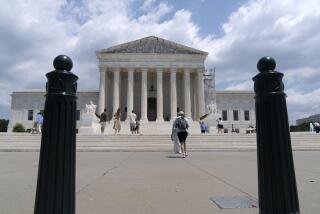Religion and the Court
The relationship of church and state remains a thorny and litigious subject, judging by the number of cases that continue to come before the U.S. Supreme Court every year. New issues keep cropping up, presenting new circumstances that call for new rulings. In the term now ending, the court decided a number of important church-state cases, always taking the view that the First Amendment requires an inviolable wall between government and religion. Despite indications in the last year or two that the court was moving to a different opinion, this term was a resounding victory for the Establishment Clause of the Constitution, which holds that “Congress shall make no law respecting an establishment of religion.”
On Monday the court decided two so-called shared-time cases--one from Grand Rapids, Mich., one from New York--in which public-school teachers were spending part of their day teaching in parochial schools. The facts of the cases were decidedly different--New York’s program seemed to have been more carefully planned to avoid a constitutional problem--but the court, by 5-4 votes, said that both programs were unconstitutional. “State-provided instruction in the religious school buildings threatens to convey a message of state support for religion to students and to the general public,” Justice William J. Brennan Jr. wrote for the majority.
These two rulings came on the heels of a decision last week in which the court held, 8 to 1, that states may not enact laws giving employees the absolute right to refuse to work on their sabbath. A month ago, once again relying on the Establishment Clause, the court ruled that a “moment of silence” in public schools for the purpose of prayer was also barred by the Constitution.
All these cases properly reinforce the orthodox doctrine that the government may not advance religious interests. But, at the start of the term, few court-watchers would have bet that that was the way they would turn out. In recent terms the court had upheld the legality of tuition tax credits, upheld the right of a state legislature to employ a chaplain to open its sessions and, worst of all, allowed a city to erect a Nativity scene on public property.
This term’s four religion cases had all been decided by lower courts on strict separation-of-church-and-state grounds. When the Supreme Court agreed to hear the cases, many people feared that it would reverse at least a few of them. But the justices affirmed all four lower-court decisions and decided that they would not rewrite Establishment Clause jurisprudence.
The only fly in the ointment was that Monday’s cases were decided 5 to 4, with Justice Lewis F. Powell Jr. as the deciding vote. The court has a liberal wing and a conservative wing, and its decisions are in the hands of the shifting middle, which, increasingly, is Powell. Because of illness, he missed 60 cases this year, and the court was deadlocked, 4 to 4.
But the court came through this year’s religion cases with flying colors. It decided, narrowly sometimes, that the Constitution means just what it says.
More to Read
Sign up for Essential California
The most important California stories and recommendations in your inbox every morning.
You may occasionally receive promotional content from the Los Angeles Times.










